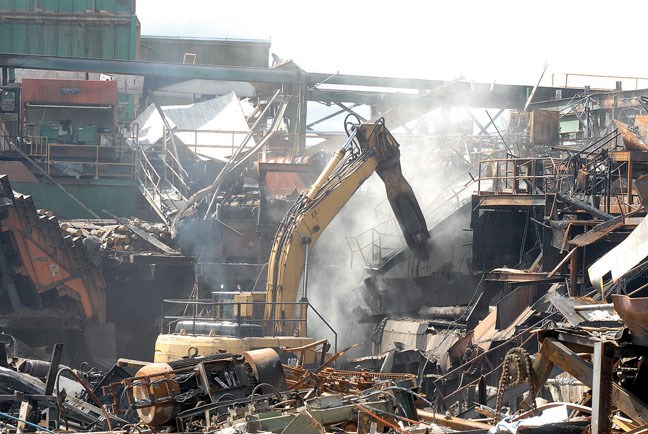BURNS LAKE — The air inside a Burns Lake sawmill was so filled with static electricity on the day it was destroyed that hair was seen standing on end, a survivor of the blast told a coroner's inquest into the fatal explosion on Thursday.
Jim Weselowski, a cant saw operator, said he was helping a co-worker change a bandsaw when he noticed the phenomenon.
"The hair on our arms was standing straight up," Weselowski said. "You could feel the hair on your head, your arms and your legs. There was a lot of static electricity for some reason."
In the 30 years he had worked at Babine, its was a first for Weselowski.
"I had never felt that before."
Weselowski figured it was due to the extreme cold that had settled over the community of 2,000 people 225 kilometres west of Prince George combined with a poor effort at preparing the sawmill for the winter.
With the windchill, the temperature had dropped to as low as -45 C a few days before the Jan. 20, 2012 blast that killed Robert Luggi, 45, and Carl Charlie, 42, and left roughly 20 injured, many with serious burns.
"They just stapled plastic over windows, over the openings, and it seemed to create sort of a static in the mill," Weselowski said.
Earlier in the week, an expert on dust-fueled explosions said static electricity is enough to spark a blast if there is enough dust in the air.
Others who have testified were also critical of the work done to "button up" the sawmill for winter and said they had to cope with burst water pipes and gummed up lubrication as a result.
Weselowski said he had just opened the door to an operator's shack in the mill's northwest corner when the blast hit and knocked him inside the structure.
He went back outside only to be knocked back into the shack by another blast.
"It's like it went right through your body, it just shook everything inside you," Weselowski said.
He and a co-worker who was also inside the shack pounded on the door until someone opened it, "and then we left."
He said the shack was all metal other than the door, and remained intact despite the blast.
Weselowksi said he noticed a smell of warm plastic shortly before the explosion, which occurred shortly after 8 p.m.
A WorkSafeBC investigation narrowed the ignition source down to the friction from a v-belt rubbing against sawdust compacted underneath a guard overtop of the assembly for a motor and gear reducer located in the mill's basement.
Weselowski said the dust level in the mill increased significantly once it began to process beetle-killed pine, which created a dry sawdust that would hang in the air and create a haze.
Efforts to improve the environment went nowhere, the inquest heard.
"That mill was not designed for pine dust," Weselowski said.
"The way I looked at it, it was designed for green lumber, not dry wood. That's what they had a hard time trying to keep up with. They kept changing things, putting in the vacuum system, putting in more conveyors and hanging mats so the dust would go down into the conveyors."
Others who testified also said the dry dust was posing problems, particularly after the amount of time dedicated to processing lumber was increased to 20 hours per day, five days a week, from eight hours a day.
It was a measure taken by the mill's majority owner, Oregon-based Hampton Affiliates, who acquired Babine in 2006, after lumber prices crashed because of slowdown in house building in the U.S.
For a time, employees were on a workshare program - where they worked part of the week and received Employment Insurance for the rest - as a result of the downturn and appeared willing to go along with the change.
At first, workers on the production shifts worked four 10-hour shifts, but that was eventually increased to five shifts per week, with many earning overtime wages as a result.
However, it also meant less time for cleanup and maintenance crews to do their work, the inquest heard.
By the time Hampton bought Babine, it was 30 years old.



